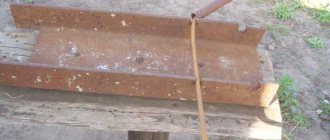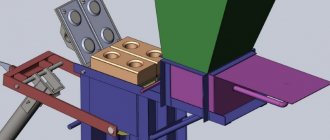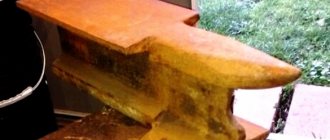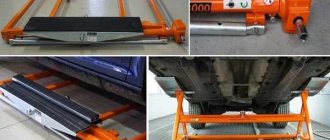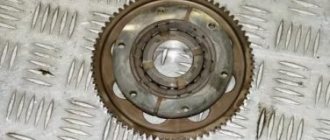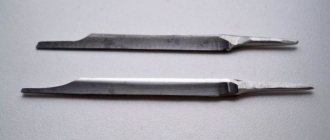DIY metal hole puncher
Hello to all DIY lovers. In this article I will tell you how to make a metal hole punch with your own hands, which will be useful in creating holes in sheet metal, as well as other materials.
The assembly of this homemade product does not require any hard-to-find parts; car parts are sufficient.
Before you start reading the article, I suggest watching a video that shows in detail the assembly process and testing of a homemade tool.
In order to make a hole punch for metal with your own hands, you will need:
* Automotive tie rod * Valve * Cuttings from turning cutters * Disc cutter * Metal lathe * Welding machine * Welding mask, gauntlets * Hammer * Metal plate 2 mm thick * Two M6 bolts * Spring, washer * Gloves, safety glasses, headphones * Angle grinder, cutting disc
You also need to cut a 2 mm thick plate from sheet metal, and then drill two holes in them with a 6 mm drill.
Step five.
It's time for welding work. We weld two cuts of the cutter to the steering rod with a small gap relative to each other, and one should be about 15 mm longer than the other.
When working with a welding machine, be careful and use a welding helmet and gloves.
This hole punch is useful when working with sheet materials in which you need to quickly and evenly make holes of the same diameter. In this case, the diameter of the holes made using a homemade hole punch is 6 mm; if necessary, this parameter can be changed by making a rod of the required diameter.
That's all for me, thank you all for your attention and creative success.
Source
Manual hole punch for metal: do it yourself and save money
All those who are involved in metalworking work with sheet metal know how important it is to competently and accurately make holes in sheet metal. The quality of the final work directly depends on how accurately these holes are made. Of course, nowadays there are a lot of different devices capable of making high-quality holes in fairly thick metal, but they are all expensive. It’s obvious that we want to save on such a purchase, but is this possible?
This article will talk about how to make a high-quality and effective hole punch with your own hands . Let's get started!
All the necessary items for this project are shown in the photo below. As you can see, we need:
- Two metal parts fastened together using fasteners
- Spring
- Sharp tip
Ordinary metal rods or handles from metal scissors can also act as metal handles. The main thing is that our homemade product creates enough leverage to pierce a sheet of metal.
In order for our tool to acquire the desired functionality, it is necessary to equip it with a special durable tip . The easiest way to make a tip for our device is to grind it out of a metal drill. Such drills are usually made of very durable and high-quality steel with good technical and operational properties. Our homemade product needs similar characteristics if we plan to use it often.
Below is an example of our homemade product in action. For additional comfort, you can equip the device with a return mechanism (a regular spring). This is necessary so that you do not have to return the tool to its original position each time.
Manual Hole Punch for Sheet Metal
This publication presents three tool options for punching holes in sheet metal . If you want to find out what exact templates and drawings to make a hole punch for your workshop, then watch the video of the “Garage 91 Gomel” channel at the very end of the article.
Another master, Ilya Konakov, made a video on his channel about how to make a hand-held hole punch that can easily handle sheet metal. The idea arose during the work on replacing the bottom on the nine. Those who do body repair know what it means to drill a lot of holes.
Everything is welded through the holes. In order not to do this with a screwdriver or drill, the master decided to improve the technology. The firmware took approximately 3 hours. Available materials were used. The video shows the entire mechanism and what it is made of. How to work with sheet metal. The force is small, although it is advisable to press the hole punch with both hands. The holes are 7 millimeters.
The tip is sharpened like a stationery hole punch. The master took the roller from the bearing and hammered it inside. Sharpened it with a hollow. More than one hundred holes were made using this mechanism. The result is a convenient tool for car repair and not only for that.
Another model of a homemade hole punch for metal. This is a hand tool for making holes in plastic, iron, paper, textolite. No drill required. The master shows how convenient it is to work with this tool; no irregularities, burrs, etc. are formed.
Convenient to use in the workshop or at home for installing plasterboard panels. You can also punch holes and install rivets in the same way. The dragon's honor that pierces the metal is called a sleeve. It can be of different sizes. In the previous video it was 7 millimeters, here it is 5. The sleeve also comes in smaller sizes, for example 2, 3 millimeters. Some copies have a window for working with non-standard sheets and parts.
Another homemade model of a hole punch - a cutter for metal (Vlad ShchCh channel). What are its features? There is a hole, it is planned to make an adjusting plate and tighten it with a screw. Using this part you can change the depth of the hole. The top part is removable. It can be changed. There are several different options you can make. The master explained what parts the rest of the instrument consists of.
The last video shows the dimensions of the hole punch and how it performed in operation.
Source
Alternative options
There are also more labor-intensive processes that few people want to work with.
- Beautiful holes in a homemade postcard can be made with a brass tube, well sharpened, on one side. To make everything look original, you should choose a tube with a square cross-section. In this case, you need to place a soft board under the postcard, and gently tap the tube with a hammer until a hole is created.
- Instead of a hole punch, holes can be made with a scalpel or even a stationery knife. The work is quite painstaking, but the result will be the same as originally wanted. You can get a shaped hole by cutting it out with 2 screwdrivers.
At home, you can easily find something to replace a hole punch with. It all depends on the availability of free time and the tools that are at hand.
Hello to all DIY lovers. In this article I will tell you how to make a metal hole punch with your own hands, which will be useful in creating holes in sheet metal, as well as other materials.
The assembly of this homemade product does not require any hard-to-find parts; car parts are sufficient.
Before you start reading the article, I suggest watching a video that shows in detail the assembly process and testing of a homemade tool.
In order to make a hole punch for metal with your own hands, you will need:
* Automotive tie rod * Valve * Cuttings from turning cutters * Disc cutter * Metal lathe * Welding machine * Welding mask, gauntlets * Hammer * Metal plate 2 mm thick * Two M6 bolts * Spring, washer * Gloves, safety glasses, headphones * Angle grinder, cutting disc
Manual edge bender - how to do it yourself, characteristics
You can bend a metal product in different ways, but without special tools the quality will be low. Using an edge bender you can solve many issues related to the preparation of parts from metal sheets.
This makes it possible to prevent the formation of corrosion in the future and to produce elements of increased strength. The technique of working with the technical tool is simple. On its scale, it is enough to set the necessary bending parameters, insert a plane between the main and clamping parts and, moving, bend the edge.
This does not require significant effort or heating of the metal. Processing of products made of copper, aluminum, metal alloys and carbon steel is carried out by bending on machines or manually.
Some nuances when working
To use a hole punch successfully, you need to know some features of working with it:
- To prevent the strips from bursting when drilling holes, it is advisable not to sharpen the needles to perfection. The sharper the needle, the more likely it is that the bar will burst.
- Be careful how you position the strip in relation to the edges of the hole punch. It is better if there is an additional limiter installed that you can focus on.
- It is also important to apply the right and left sides of the frame equally so that the holes go synchronously on each of them.
- When creating your own hole punch, it is very important to calculate everything down to the millimeter, center the screws or self-tapping screws with which you will make holes. Only with proper fastening of all the parts can you count on the frames coming out with even holes at the same distance from each other and exactly in the center of the bar.
- To prevent the hole punch from moving during operation, it is best to consider attaching it to a work surface or table.
This is interesting. Differences between an alpine hive and a regular one and its advantages.
Device of manual edge benders
Edge bending machines are designed in such a way that the force acts simultaneously along the entire length of the edge or sheet blank. As a result, at the same time, the edge is deformed, but the metal does not warp, but lies in an even seam.
The designs of such equipment are divided into types:
The modern market provides the opportunity to purchase different designs of sheet bending devices, but you can make them yourself.
Areas of application
Metal bending devices are used in various industries. They are used to create folds from roofing iron, make rectangular air ducts from tin or metal sheets, prepare the edges of products for welding, and parts of geometric shapes. Manual edge benders are actively used for construction and repair work. They are in demand during car repairs.
Among the advantages of this technology, in addition to the small thickness of the resulting edges and the low cost of rolled metal, one should add high resistance to wear.
Main varieties
Edge bending equipment is available in the form of mobile and stationary models. The designs of the machines are massive and practically cannot be disassembled.
They are mounted directly at the place of use, and are moved only with the help of technical means.
A special place in the product line belongs to segmented manual devices intended for the manufacture of cases, boxes, i.e. products “closed” on all sides.” Due to the different configurations, the segments can be installed arbitrarily. Such equipment allows you to obtain any bending length that does not exceed the working length of the machine.
Tool models differ from each other not only in power, efficiency and thickness of the materials processed, but also in the type of metal.
Portable models of edge benders with gradual shaping consist of:
Roller-type hand-held products have the simplest design. The whole process is carried out by a handle, and the main task of deforming the metal is performed by rollers. The bending width is regulated by a special limiter installed on the tool guides.
In a roller edge bender, friction during sliding of the jaws replaces rolling friction during rotation of the rollers. In this case, the forming force is significantly reduced, but the design of the tool is less universal, because it is impossible to change the edge formation parameters due to one pair of rollers. In addition, edge benders with rollers do not make it possible to carry out beading of small radii inside the product.
A significant disadvantage of portable models of hand tools is their lack of accuracy. As the device moves along the line of the future edge, the error gradually increases, which can reach more than a millimeter. This is unacceptable for work such as auto body repair, so the quality of the edges depends on the experience of the specialist. Because of these technical characteristics, it is advisable to use a roller edge bender only for solving simple problems.
A machine with a hydraulic drive is more functional. Thanks to its high power, it copes well with workpieces made of metal sheets, even of considerable thickness.
Homemade hole punch
You can make a hole punch yourself, especially if you understand the principle of its operation and know how to connect the necessary parts together. Each craftsman comes up with his own design, but their basis is approximately the same:
- There must be a motor or several that puts the structure into action and runs from some kind of power source. Some people order motors separately, new and simple ones. Others take them from already unused household appliances, such as a sewing machine.
- You need needles to make holes. The main requirement for them is strength. And if you notice that even the needles of a hole punch purchased in a store quickly begin to bend, then you can safely replace them with self-tapping screws. The holes are made even better, it is easier to thread wire through them, and they will last much longer.
- For the base, you can take any boards or scraps from furniture, beehives and other wooden scraps that you have.
- Some attach a handle and fastenings for the planks to the structure, as on purchased models, while others do without them, simply holding the plank with their hands.
This is interesting: Two-queen bee breeding
The advantage of a homemade hole punch is that you can make the desired number of holes in the slats, place them at the distance you like, and the ability to experiment.
Let us describe a short instruction for one of the do-it-yourself hole punch options:
- You will need a motor, a movable table or furniture scraps for the base, diodes from old equipment, a limit switch, a toggle switch, furniture ball guides, screws, drills and screws for fastening.
- Make a base out of boards, attach screws to the motors and fasten them at the required distance from each other.
- Connect all the elements together according to the diagram.
You can make such a device in one evening and you have your own hole punch, which will save a lot of time.
Video: hole punch for frames - save time and labor costs.
How to make a manual edge bender for auto repair
To save money, you can make a homemade edge bender for body repair. It will greatly facilitate the production of, for example, patches on the threshold or fender of a car.
In this case, the repair site will not protrude above the surface, which will reduce the time and costs of puttying and painting.
A roller model for bending sheet metal can be made from:
The process of making a roller model for bending sheet metal
Tinsmith's Tool
Such an edge bender is necessary during auto repair for a smooth transition of the metal patch to the base. After straightening, both planes must be coaxial with each other.
On a thin sheet of iron, it is impossible to guarantee the reliability of the butt weld joint. The device allows you to prepare an edge profile for overlap welding. It greatly simplifies the process of repairing a car body if you need to bend the metal at an angle of 90 degrees, i.e. make an edge or flange. Edge bending devices for auto repair are characterized by a simple design and low price, so making them yourself is not always impractical. Sometimes it is better to buy equipment for which there is an additional use in the household.
Video instructions on how to use a tinsmith's edge bender
Pneumatic edge bender
Particularly popular among craftsmen are edge benders with pneumatic drive, which work as a “rotary beam”. The pneumatic drive contributes to significant pressure (up to 6.2 bar) on the workpiece. But such equipment can be used when working with sheet metal no thicker than 1.2 mm. In this case, the edge width will be no more than 12 mm.
If you want to make a pneumatic machine with your own hands, you must take into account that its operation requires an air flow of at least 113 l/min.
Pneumatic punch
This is a universal tool model. On one side, the structure is equipped with a mechanism for punching holes, on the other, with jaws for forming an edge.
Thanks to this, you can simultaneously bend the edge and make holes in the metal for fasteners. That is why the tool is often called a pneumatic punch. Its working part is made of high-speed steel. The rubberized handles of the product are equipped with springs. They help reduce pressure on the palm, which facilitates the process of punching and processing.
Any model of hole punch-edge bender works much faster and more efficiently than its manual counterparts, which is why it is intensively used at service stations and car repair shops.
How to make a paper hole punch with your own hands
To make it easier to pierce the sheet, it is better to preheat the awl on a gas burner. You can also use a regular lighter.
In this case, it is important to carefully monitor how hot the soldering iron is; if you are careless, you can make a large hole and get burned.
A hole punch is a mechanical device that is designed to quickly punch holes in paper. There are tools that can be used to work with denser materials. Manufacturers offer hole punchers that can make one or four holes at a time.
How does an edge bending machine work?
Structurally, a metal bending machine consists of several parts:
Some models are equipped with a hole punch and a knife for trimming edges. In the standard design, the supporting plane measuring 1m x 1.5m is a table made of wood or metal with powerful legs. The horizontal fastening of the base is made from channel No. 8 or 6.5. Metal structures are connected by welding, and wooden structures are connected by bolts.
Clamp
To clamp the surface when bending the edges, the device is equipped with a pressure bar - an angle with a shelf of 0.05 m. It presses against the punch at a given angle. Holes for bolts are drilled on both sides of the clamping mechanism. Also for clamping, “lambs” with pins welded to the base are used. More complex clamping parts are equipped with springs.
Punch
To make a punch, a square section of pipe is often used. The design of a part involves its horizontal rotation around an axis. In this case, the upper edge in front of the base exactly coincides with the punch.
For this purpose, the ends are equipped with loops. The clamp is located exactly vertically so that there are no distortions when bending metal. The punch is adjacent to the edge of the base without gaps so that the fold line is accurate. When not in use, the top edge of the punch is located in the same plane as the table plane. If the design has deviations, the fixture will work, but with an increased bend radius, which leads to a rounded straight line.
Drive unit
A manual drive made from a pair of pipe sections is connected by welding to the front or side of the punch. It can be in the form of a bracket or a telescopic lever. The length of the lever is firmly fixed for specific positions using pins connecting through the holes in increments of 0.1 m. This handle helps to distribute the load evenly, adjusting the force on the surface depending on its thickness. For example, the telescopic shape of the lever during body work allows you to increase the effort by more than 2 times.
DIY handmade metal hole puncher drawings
This publication presents three tool options for punching holes in sheet metal . If you want to find out what exact templates and drawings to make a hole punch for your workshop, then watch the video of the “Garage 91 Gomel” channel at the very end of the article.
Another master, Ilya Konakov, made a video on his channel about how to make a hand-held hole punch that can easily handle sheet metal. The idea arose during the work on replacing the bottom on the nine. Those who do body repair know what it means to drill a lot of holes.
Everything is welded through the holes. In order not to do this with a screwdriver or drill, the master decided to improve the technology. The firmware took approximately 3 hours. Available materials were used. The video shows the entire mechanism and what it is made of. How to work with sheet metal. The force is small, although it is advisable to press the hole punch with both hands. The holes are 7 millimeters.
The tip is sharpened like a stationery hole punch. The master took the roller from the bearing and hammered it inside. Sharpened it with a hollow. More than one hundred holes were made using this mechanism. The result is a convenient tool for car repair and not only for that.
Another model of a homemade hole punch for metal. This is a hand tool for making holes in plastic, iron, paper, textolite. No drill required. The master shows how convenient it is to work with this tool; no irregularities, burrs, etc. are formed.
Convenient to use in the workshop or at home for installing plasterboard panels. You can also punch holes and install rivets in the same way. The dragon's honor that pierces the metal is called a sleeve. It can be of different sizes. In the previous video it was 7 millimeters, here it is 5. The sleeve also comes in smaller sizes, for example 2, 3 millimeters. Some copies have a window for working with non-standard sheets and parts.
Another homemade model of a hole punch - a cutter for metal (Vlad ShchCh channel). What are its features? There is a hole, it is planned to make an adjusting plate and tighten it with a screw. Using this part you can change the depth of the hole. The top part is removable. It can be changed. There are several different options you can make. The master explained what parts the rest of the instrument consists of.
The last video shows the dimensions of the hole punch and how it performed in operation.
I also needed it once, I equipped a punch with old healthy Soviet pliers, they pinned down to a millimeter with a bang.
Somehow you have a lot of force, you push with both hands, the gaps may be large in the counter part, good material there is also important, as on the punch
Hello to all DIY lovers. In this article I will tell you how to make a metal hole punch with your own hands, which will be useful in creating holes in sheet metal, as well as other materials.
The assembly of this homemade product does not require any hard-to-find parts; car parts are sufficient.
Before you start reading the article, I suggest watching a video that shows in detail the assembly process and testing of a homemade tool.
In order to make a hole punch for metal with your own hands, you will need:
* Automotive tie rod * Valve * Cuttings from turning cutters * Disc cutter * Metal lathe * Welding machine * Welding mask, gauntlets * Hammer * Metal plate 2 mm thick * Two M6 bolts * Spring, washer * Gloves, safety glasses, headphones * Angle grinder, cutting disc
Step one.
We install the disk cutter into the three-jaw chuck of a metal lathe using a special mandrel; if you have a milling machine, you can make a groove on it.
Self-production
Following the drawings, you can make your own manual edge bender for processing metal of small thickness during car repair.
It is enough for him:
Preparatory stage
To make it easier to turn the machine while bending a sheet of metal, attach handles on both sides. Using clamps, attach the machine to the table.
For processing, the product is placed between the profile and the corner. The gap for it is formed after unscrewing the corner. The metal sheet is aligned along the edge and bent by turning the device by the handles.
Long straight edge bending machine
Making your own manual edge bender for long straight edges should begin with studying the drawings, as well as selecting the equipment and necessary materials:
4 main details:
First, you need to chamfer the edge of the crimping punch and weld the axles to it. The axes of the bar itself must coincide with the edge of the angle. Samples are made at the ends of the working part of the clamp.
For assembly, the base with the punch is clamped in a vice. In this case, the walls of the first and second shelves must be in the same plane. The gap between the parts will be created by a cardboard spacer. After this, the elements are firmly fixed in a vice.
Brushes with metal bristles are placed on the punch axis. These components are attached to the base using a clamp - a frame with a movable clamp.
Then the brushes are welded to the channel, and holes are drilled in the base into which the clamping bolts are screwed. Screw nuts onto hardware studs. Then they are welded to the channel.
After unscrewing, the bolts are inserted into the clamping holes and the limiting nuts are screwed onto them.
The handle-bracket is welded to the corner. The final stage of assembling the structure is installation in a vice.
Manual edge bender for flanging
Beading is a method of bending an edge on cylindrical or oval products. During operation, the material stretches. Its value depends on the properties and thickness of the material, the inclination of the flanging angle, and the parameters of the edge.
Flanging is performed on a machine or using a manual edge bender with your own hands. This processing technology is necessary in preparation for soldering, welding, and in the manufacture of any flange.
Do-it-yourself manual edge bending - saving the family budget
Many people are interested in how to make an edge bender themselves, and how difficult it is. Making a simple design will take several evenings and save several thousand rubles. Another argument may be the urgency of use.
For example, for auto repair, using a hand-made edge bender will save time and nerves. But such equipment may be inferior to factory products in terms of accuracy and manufacturability.
Video - how to make an edge bender yourself
Use of the device
A frame hole punch is needed if you need to drill a lot of holes in the side strips. If you have a large apiary and you prepare the frames yourself, then the advantages of such a device become obvious to you:
- Saving a huge amount of time for other types of work in the apiary or at home. After all, holes are made literally in seconds, five or more at a time.
- Your strength is also important, and therefore the hole punch saves them too. You don't have to sit through the monotonous work of drilling holes. Even from physically uncomplicated, but long-term monotonous work, you can get no less tired than from a heavy load.
- If you make the frames yourself, and also use a homemade device, you will also save a significant amount of money, which is important in our times.
- The hole punch takes up little space and there is almost no debris left from its operation, and therefore it is a fairly comfortable device. Most of them also work quietly, without making any noise, which your pets will appreciate.



